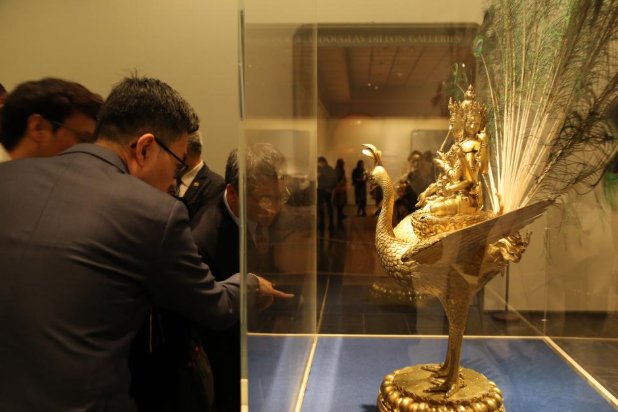Sewage may offer clues to virus origin


Tests point to global circulation for months before first case confirmed
Like mini time capsules, frozen sewage samples can provide a wealth of information about the health and habits of people living within the catchment areas of wastewater treatment plants.
Levels of illicit drug use as well as pharmaceuticals and other chemical compounds are monitored in communities around the world through techniques in the field known as wastewater epidemiology.
Experts are now calling for more rigorous detection of the novel coronavirus in sewage systems, as evidence mounts that the pathogen was already widely circulating the globe well before the first known cases of infection in China.
Recent retrospective analysis of sewage from Spain, Italy and Brazil have returned positive tests for the novel coronavirus in samples taken as far back as March last year, well in advance of the first documented instance of COVID-19 in China in late December.
On Monday, Brazilian researchers announced they had found fragments of genetic material from the virus in a sewage sample collected on Nov 27 in the city of Florianopolis. The finding predates the first case of COVID-19 in Brazil by 91 days and is also ahead of the initial confirmed infections in the United States which came in late January.
Italian scientists announced similar results on Thursday for samples collected in Milan and Turin on Dec 18, and analysis of Barcelona sewage retrieved on March 12 also showed signs of the virus, according to a study published in mid-June.
The findings have paradoxically shed light on and further complicated what we know about the origins of the novel coronavirus pandemic. They have also provoked calls for more project funding and increased international collaboration among researchers involved in the unglamorous yet valuable field of sewage science.
Techniques to measure drugs and chemicals in sewage have been perfected over the last two decades, while those that monitor potential outbreaks of disease are more recent.
Scientists in several countries began testing for the novel coronavirus in wastewater in the spring, after it was confirmed the virus could be detected in feces and urine. In March, researchers in the Netherlands found the virus in samples collected at a wastewater plant near Utrecht, weeks before the city's first confirmed case of COVID-19.
"Even if people are in the early stage of infection, without symptoms, their stool can still contain virus particles," said Yang Zhugen, a lecturer in sensor technology at the Cranfield Water Science Institute in the United Kingdom.
Yang has worked in wastewater epidemiology technology for a decade, and recently developed a device that can test for novel coronavirus on site at treatment plants. He is participating in a project launched on Thursday by the UK government that is monitoring the novel coronavirus in sewage across the country, so authorities can get ahead of potential localized outbreaks. Yang was not involved in the studies from Italy, Brazil or Spain.
"This methodology is very promising," Yang said. "The findings from Italy and Spain are very interesting. I would be keen to see more to confirm the results and more strong evidence to conclude the origin of this virus, because I think everybody is interested to know where it is from and how it spread through the world."
Yang says that if the findings from the University of Barcelona-led study are validated, it could be said with confidence that novel coronavirus was present in Europe more than nine months before the first confirmed case of human infection in China.
He provides the caveat that there is no way of knowing if the virus particles found in the samples were excreted by humans or other animal species harboring the pathogen. He also said that in order to corroborate the findings, more robust testing needs to be done.
Such studies initially use methods that analyze very small fragments of genetic material. Closely related organisms-including viruses in the same family-can have similar segments of DNA and RNA, meaning researchers must run repeated and varied tests on several samples to reach clear conclusions.
The study in Italy, which was led by the Italian National Institute of Health, used two separate methods of genetic analysis, and also tested more gene sequences from a larger number of samples than the Barcelona study.
More research needed
Yang said he finds the Italian study "quite convincing", and he would like to see more extensive testing of the Barcelona sewage samples. He said in both cases, whole sequencing of the virus would provide evidence of a higher standard.
Davey Jones, a professor of soil and environmental science at Bangor University, agrees that more tests are needed. Jones has run extensive novel coronavirus testing in wastewater in Wales and is also part of the government-backed project launched in the UK on Thursday.
"The Italy study looks more credible just in terms of timelines," Jones said.
"The reports are interesting, but I think more research is needed to definitively say this is really the case for the Spanish dataset, specifically they need to rule out the possibility of laboratory contamination. They also need to sequence the strain of the virus before we can really say that their results are correct."
Oliver Pybus, a professor of evolution and infectious disease at the University of Oxford, said that positive tests results from November onwards align with the majority of research undertaken into the origins of the pandemic.
"The results of the Italy study are more consistent with all the other information we have about the epidemic history," Pybus said.
Yang said that labs around the world need to collaborate closely and agree on standardized methods as they use this "exciting but emergent" way of tracking the spread of the novel coronavirus.

































